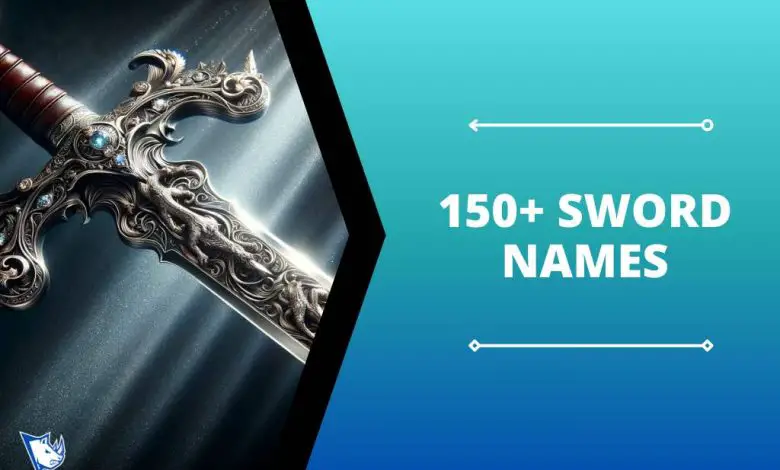150+ Sword Names For Legends Of Steel

The sword, more than just a weapon, has carved its way through history and mythology as a symbol of power, justice, and valor.
From the mystical forges of legendary smiths to the skilled hands of historical craftsmen, the names given to these blades often reflect their deeds, their wielders, or their extraordinary qualities.
This collection seeks to honor the diversity and significance of swords across various cultures and eras, offering a glimpse into the stories that have made them immortal.
Read Also>> Hood Nicknames
Sword Names
- Excalibur – The legendary sword of King Arthur, symbolizing divine kingship and the right to rule.
- Masamune – Named after the famed Japanese swordsmith, representing unparalleled craftsmanship.
- Joyeuse – The personal sword of Charlemagne, denoting royal authority and the Carolingian Empire’s might.
- Kusanagi-no-Tsurugi – A mythical Japanese sword part of the Imperial Regalia, embodying valor and the spirit of the samurai.
- Durandal – The unbreakable sword of Roland, emblematic of indomitable strength and heroism in the face of overwhelming odds.
- Zulfiqar – Associated with Ali ibn Abi Talib, representing divine justice and courage in Islamic tradition.
- Caladbolg – A legendary sword in Irish mythology, known for its destructive power and association with the hero Fergus mac Róich.
- Gram – In Norse mythology, Sigurd used this sword to slay the dragon Fafnir, symbolizing heroism and destiny.
- Durendal – Another name for Durandal, highlighting its storied past and the epic feats associated with it.
- Andúril – Forged from the shards of Narsil in J.R.R. Tolkien’s Middle-earth, symbolizing the resurgence of a rightful king.
- Hrunting – Beowulf’s sword, representing loyalty and service, as it was lent to him for a heroic deed.
- Curtana – The ceremonial sword of English coronations, symbolizing mercy in its blunted edge.
- Almace – The sword of Turpin, Archbishop of Reims, in “The Song of Roland,” emblematic of divine guidance in battle.
- Claíomh Solais – In Irish mythology, the “Sword of Light,” denoting the triumph of light over darkness.
- Tizona – The sword of El Cid, symbolizing the virtues of a perfect knight in Spanish folklore.
- Stormbringer – From Michael Moorcock’s saga, a powerful, soul-devouring sword.
- Glamdring – Gandalf’s sword in “The Lord of the Rings,” known as the “Foe-hammer.”
- Mourneblade – The sister sword to Stormbringer, equally dark and powerful.
- Ice – The ancestral greatsword of House Stark in “A Game of Thrones.”
- Longclaw – Jon Snow’s Valyrian steel sword from “A Game of Thrones.”
- Orcrist – The “Goblin-cleaver” sword found by Thorin Oakenshield in “The Hobbit.”
- Sting – Bilbo Baggins’ Elvish dagger-sword in “The Hobbit” and “The Lord of the Rings.”
- Brightroar – A lost Valyrian steel sword of House Lannister from “A Game of Thrones.”
- Needle – Arya Stark’s slender sword in “A Game of Thrones.”
- Heartsbane – The ancestral Valyrian steel sword of House Tarly in “A Game of Thrones.”
- Widow’s Wail – One of two swords made from Ice, owned by Joffrey Baratheon in “A Game of Thrones.”
- Oathkeeper – The other sword made from Ice, given to Brienne of Tarth in “A Game of Thrones.”
- Dark Sister – A Valyrian steel sword wielded by Visenya Targaryen in “A Game of Thrones.”
- Blackfyre – The ancestral sword of House Targaryen in “A Game of Thrones.”
- Lightbringer – The legendary sword associated with Azor Ahai in “A Game of Thrones.”
- Terminus Est – The executioner’s sword from Gene Wolfe’s “The Book of the New Sun.”
- Twinkle and Icingdeath – Drizzt Do’Urden’s scimitars in R.A. Salvatore’s “The Legend of Drizzt.”
- Frostmourne – The cursed runeblade from “Warcraft” lore.
- Soul Edge – A cursed sword from the “Soulcalibur” video game series.
- Soul Calibur – The spirit sword designed to combat Soul Edge in the “Soulcalibur” series.
- Monado – A mythical sword from the video game “Xenoblade Chronicles.”
- Master Sword – The legendary sword from “The Legend of Zelda” series.
- Falchion – The divine sword from the “Fire Emblem” series.
- Keyblade – A magical weapon from the “Kingdom Hearts” video game series.
- Gunblade – A weapon combining a sword and a firearm from “Final Fantasy VIII.”
- Ragnell – Ike’s magical sword in “Fire Emblem.”
- Buster Sword – Cloud Strife’s enormous sword from “Final Fantasy VII.”
- Dragon Slayer – Guts’ massive sword from the manga and anime “Berserk.”
- Vorpal Sword – A mythical sword from Lewis Carroll’s “Through the Looking-Glass.”
- Lævateinn – A weapon in Norse mythology, sometimes considered a sword.
- Tyrfing – A cursed sword from Norse mythology that causes death to its wielder’s enemies.
- Dyrnwyn – The “White-Hilt” of Rhydderch Hael, a legendary sword in Welsh mythology.
- Caledfwlch – An early name for Excalibur in Welsh legends.
- Hrotti – A sword belonging to the dragon Fafnir in Norse sagas.
- Skofnung – The legendary sword of Danish king Hrólf Kraki, famed for its supernatural sharpness and hardness.
- Gurthang – The black sword of Túrin Turambar in Tolkien’s Middle-earth, said to absorb its wielder’s sorrow.
- Nothung – Siegfried’s sword in the Nibelungenlied and Wagner’s Ring Cycle, symbolizing heroism and destiny.
- Clarent – The “Sword of Peace” used in King Arthur’s coronation, later stolen by Mordred.
- Curtana – The ceremonial sword of English coronation, symbolizing mercy with its blunt edge.
- Ascalon – Named after the lance St. George used to slay the dragon, symbolizing victory over evil.
- Balmung – Another name for Nothung, Siegfried’s sword in Germanic mythology.
- Galatine – The sword of Sir Gawain in Arthurian legend, representing the virtues of chivalry.
- Rhongomyniad – King Arthur’s spear, but sometimes depicted as a lance or sword, symbolizing royal authority.
- Almace – The sword of Turpin, Charlemagne’s Archbishop, symbolizing divine wrath in battle.
- Fragarach – The “Answerer” in Irish mythology, said to force truth from those it pointed at and could cut through any shield.
- Grasscutter – Translation of Kusanagi-no-Tsurugi, which emphasizes its power to control the wind and cut through anything.
- Harpe – The sword used by Perseus to decapitate Medusa in Greek mythology, symbolizing triumph over monstrous evil.
- Hofund – Heimdall’s sword in Norse mythology, signifying watchfulness and protection.
- Joyeuse – Charlemagne’s personal sword, representing the pinnacle of knightly virtue and the Carolingian Empire’s might.
- Khaless – In the “Star Trek: The Next Generation” universe, the mythical sword of the Klingon warrior Kahless, embodying honor.
- Mimung – In Germanic legend, the sword of the hero Witege, known for its incredible sharpness.
- Nægling – Beowulf’s sword used in the battle against the dragon, symbolizing the hero’s courage.
- Sikanda – The mythical sword of Alexander the Great, symbolizing conquest and empire.
- Tyrfing – A cursed sword from Norse mythology that guarantees victory but doom to its bearer.
- Sword of Attila – Said to have been given to Attila the Hun by Mars, the god of war, symbolizing divine right to conquer.
- Sword of Mercy – Part of the British Crown Jewels, with a broken tip, symbolizing mercy.
- Shamshir-e Zomorrodnegar – The legendary Persian sword of King Solomon, said to control demons and spirits.
- Hauteclere – The sword of Olivier, a hero of the epic poem “The Song of Roland,” known for its beauty and deadly edge.
- Carnwennan – King Arthur’s dagger, sometimes described as a sword, known for its ability to cast darkness.
- Secace – In Arthurian legend, the sword of Lancelot, symbolizing unmatched skill and loyalty.
- The Sword in the Stone – The legendary Excalibur’s counterpart, which Arthur pulled from the stone to prove his right to rule.
- Colada – One of El Cid’s swords, taken from a Moorish king, symbolizing the Reconquista’s victories.
- Tizona – The other sword of El Cid, which could intimidate unworthy opponents into surrendering.
- Hrunting – A sword given to Beowulf, which fails him against Grendel’s Mother but represents heroic exchange.
- Blue Sword – From Robin McKinley’s novel, a magical sword that chooses a woman to wield its immense power.
- Scalpel – A sword from China Miéville’s “Perdido Street Station,” known for its supernatural sharpness.
- Avalon – The mythical island where Excalibur was forged, symbolizing paradise and eternal life.
- Glamdring – The “Foe-hammer,” Gandalf’s sword in “The Lord of the Rings,” signifying the fight against darkness.
- Foe-Hammer – Another translation of Glamdring, emphasizing its purpose as a weapon against evil.
- Orcrist – “The Goblin-cleaver,” Thorin Oakenshield’s sword in “The Hobbit,” symbolizing dwarf craftsmanship and valor.
- Sting – Bilbo and Frodo Baggins’ sword in “The Hobbit” and “The Lord of the Rings,” representing courage in unlikely heroes.
- Andúril – “Flame of the West,” reforged from the shards of Narsil, Aragorn’s sword symbolizing the return of the king.
- Herugrim – The sword of King Théoden in “The Lord of the Rings,” symbolizing Rohan’s might.
- Gurthang – The black sword of Túrin Turambar in “The Silmarillion,” absorbing its wielder’s sorrow and darkness.
- Anglachel – The original form of Gurthang, made from a meteorite and symbolizing fate and tragedy.
- Ringil – The sword of Fingolfin in “The Silmarillion,” shining like ice, symbolizing the challenge against darkness.
- Narsil – The sword of Elendil in “The Lord of the Rings,” its shards symbolizing hope amidst despair.
- Rhindon – The sword of Peter Pevensie in “The Chronicles of Narnia,” symbolizing kingship and courage.
- Dyrnwyn – A powerful sword in Welsh mythology, glowing with white fire when wielded by the worthy, symbolizing truth and justice.
- Caliburn – An early name for Excalibur, emphasizing its role as a symbol of divine power and rightful sovereignty.
- Curtana – The Sword of Mercy, part of the English Crown Jewels, known for its symbolic broken tip, denoting clemency.
- Hadhafang – The sword of Arwen in the film adaptations of “The Lord of the Rings,” representing elven grace and the strength of the women of Middle-earth.
- Grayswandir – The silver sword of Corwin in Roger Zelazny’s “The Chronicles of Amber,” symbolizing the balance between order and chaos.
- Terminus Est – The executioner’s sword in Gene Wolfe’s “The Book of the New Sun,” symbolizing the finality of death.
- Godsbane – A mythical sword in various fantasy tales, representing the power to challenge deities.
- Twinkle – One of Drizzt Do’Urden’s scimitars in “The Forgotten Realms,” symbolizing the light in darkness.
- Icingdeath – Drizzt Do’Urden’s other scimitar, named for its defeat of a white dragon, representing triumph over adversity.
- Lilarcor – A talking sword from the video game “Baldur’s Gate II,” known for its humorous commentary.
- Brisingr – In Christopher Paolini’s “Inheritance Cycle,” a sword that ignites into flame, representing power and legacy.
- Arya – A magical sword in “The Inheritance Cycle,” symbolizing elegance and deadly skill.
- The Sword of Gryffindor – In “Harry Potter,” goblin-made and imbued with the power to absorb that which strengthens it.
- Frostmourne – From “World of Warcraft,” a runeblade that traps souls, representing corruption and power.
- The Vorpal Sword – From Lewis Carroll’s “Through the Looking-Glass,” known for its ability to decapitate, symbolizing sharp wit.
- Soul Calibur – From the video game series of the same name, a holy sword fighting against the cursed Soul Edge.
- Souldrinker – A sword in various fantasy tales, known for consuming the souls of those it kills, representing insatiable hunger.
- Chaos Eater – A sword found in dark fantasy stories, known for its destructive power, representing anarchy and ruin.
- Elder Wand – Though not a sword, this artifact from “Harry Potter” shares the symbolic weight of power and destiny.
- Glamdring – Gandalf’s elven sword in “The Lord of the Rings,” known as the Foe-hammer, symbolizing light and resistance against darkness.
- Blood-drinker – A sword named for its purported thirst for blood, common in tales of vampirism and battle.
- The Ebony Blade – A cursed sword from Marvel Comics, granting power at the cost of corrupting its wielder.
- The Master Sword – From “The Legend of Zelda,” a blade of evil’s bane, representing courage and purity.
- Dragonslayer – Guts’ massive sword in the manga “Berserk,” embodying the struggle against fate.
- Stormbringer – A soul-devouring sword from Michael Moorcock’s Elric saga, symbolizing the cost of power.
- Widowmaker – A name used for swords in various stories, representing loss and mourning.
- Sunblade – A magical sword in fantasy literature that emits blinding light, symbolizing purity and the banishment of darkness.
- Demonbrandt – From the video game “Demon’s Souls,” a sword effective against demons, representing hope amidst despair.
- Foehammer – Another name for Gandalf’s sword Glamdring, emphasizing its battle prowess.
- Windseeker – A sword name suggesting mastery over the elements, common in fantasy tales.
- Moonblade – A sword name found in various stories, often imbued with lunar magic, representing mystery and change.
- Starfang – A sword forged from a meteorite, symbolizing celestial power and destiny.
- The Infinity Blade – From the “Infinity Blade” video game series, representing cycles of rebirth and struggle.
- Void Sword – In fantasy tales, a blade that manipulates the void or nothingness, representing the unknown.
- Kingslayer – A sword name that implies regicide, used in stories of rebellion and power shifts.
- Lightbringer – In “A Game of Thrones,” a prophesied sword associated with the hero Azor Ahai, symbolizing salvation.
- Night’s Edge – From “Terraria,” a sword forged from darkness, representing the overcoming of fear.
- Shadowmourne – From “World of Warcraft,” a counterpart to Frostmourne, symbolizing vengeance and retribution.
- Oathkeeper – In “A Game of Thrones,” a sword forged from Ned Stark’s greatsword, representing honor and promises kept.
- The Flaming Sword – Often found in religious and mythological stories, representing divine power and justice.
- Dawnbreaker – In “The Elder Scrolls V: Skyrim,” a sword given by the Daedric Prince Meridia, known for its effectiveness against the undead.
Conclusion
The swords listed in this anthology, from Excalibur to Tizona, are more than mere weapons; they are symbols of the cultures and stories that forged them. They represent ideals of justice, heroism, and authority, serving as a testament to the enduring human fascination with the art of the blade. These names carry with them the weight of myths and legends, battles fought, and kingdoms won, reminding us of the power of storytelling and the enduring legacy of history’s greatest swords.



